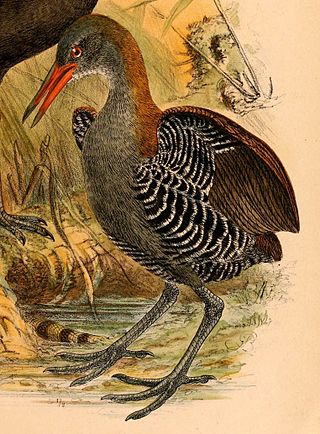
Eagle is the common name for the golden eagle, bald eagle, and other birds of prey in the family of the Accipitridae. Eagles belong to several groups of genera, some of which are closely related. True eagles comprise the genus Aquila. Most of the 68 species of eagles are from Eurasia and Africa. Outside this area, just 14 species can be found—two in North America, nine in Central and South America, and three in Australia.

Columbidae is a bird family consisting of doves and pigeons. It is the only family in the order Columbiformes. These are stout-bodied birds with short necks and short slender bills that in some species feature fleshy ceres. They feed largely on plant matter, feeding on seeds (granivory), fruit (frugivory), and foliage (folivory). The family occurs worldwide, often in close proximity with humans, but the greatest diversity is in the Indomalayan and Australasian realms.

The Gruiformes are an order containing a considerable number of living and extinct bird families, with a widespread geographical diversity. Gruiform means "crane-like".

Anseriformes is an order of birds also known as waterfowl that comprises about 180 living species of birds in three families: Anhimidae, Anseranatidae, and Anatidae, the largest family, which includes over 170 species of waterfowl, among them the ducks, geese, and swans. Most modern species in the order are highly adapted for an aquatic existence at the water surface. With the exception of screamers, males have penises, a trait that has been lost in the Neoaves, the clade consisting of all other modern birds except the galliformes and paleognaths. Due to their aquatic nature, most species are web-footed.

The limpkin, also called carrao, courlan, and crying bird, is a large wading bird related to rails and cranes, and the only extant species in the family Aramidae. It is found mostly in wetlands in warm parts of the Americas, from Florida to northern Argentina, but has been spotted as far north as Wisconsin and Southern Ontario. It feeds on molluscs, with the diet dominated by apple snails of the genus Pomacea. Its name derives from its seeming limp when it walks.

Aramidae is a bird family in the order Gruiformes. The limpkin is the only living member of this family, although other species are known from the fossil record, such as Aramus paludigrus from the Middle Miocene and Badistornis aramus from Oligocene.

The snoring rail, also known as the Celebes rail or Platen's rail, is a large flightless rail and the only member of the genus Aramidopsis. The species is endemic to Indonesia, and it is found exclusively in dense vegetation in wet areas of Sulawesi and nearby Buton. The rail has grey underparts, a white chin, brown wings and a rufous patch on the hind-neck. The sexes are similar, but the female has a brighter neck patch and a differently coloured bill and iris. The typical call is the snoring: ee-orrrr sound that gives the bird its English name.
La Venta is a fossil locality located in the modern departments of Tolima and Huila in Colombia. This site is one of the richest Neogene fossil assemblages in South America and represents the best-known Cenozoic fossil site outside of Argentina. It provides a glimpse of what life in the region was like before the main wave of the Great American Interchange.

The grey-cowled wood rail or grey-necked wood rail is a species of bird in the family Rallidae, the rails. It lives primarily in the forests, mangroves, and swamps of Central and South America. Of the two subspecies, A. c. avicenniae is found in southeastern Brazil, while the nominate is found throughout the portion of the range not occupied by the other subspecies. The species as a whole is usually found at elevations from sea level to 2,000 metres (6,600 ft), although some have been found above that. This bird's large extent of occurrence along with its population is why it is considered to be least-concern by the International Union for Conservation of Nature (IUCN). In some places, it is occasionally hunted and kept for food.

Pytilia is a genus of small brightly coloured seed-eating birds in the family Estrildidae. They are distributed across Africa.
Juan de los Santos Contreras; April 7, 1928 – December 10, 2002), was a Venezuelan singer. He was a llanero, specialising in the music of the Orinoco floodplains. He was better known by his stage name El Carrao de Palmarito which identifies him as the "limpkin" of Palmarito, his hometown.
The carau is a myth, commonly known in northeastern Argentine fables.
Aramus is a village in the Kotayk Province of Armenia. Its located at 43 km of the Getar river and 25 km of the armenian capital, Yerevan.
Aramus paludigrus is an extinct species of limpkin, semi-aquatic birds related to cranes, which are similar. Aramus paludigrus was found in the famous Konzentrat-Lagerstätte of the Honda Group at La Venta, dating from the mid-Miocene period, in central Colombia.
Aramu Rural District is in the Central District of Darreh Shahr County, Ilam province, Iran. Its capital is the village of Aramu.
Aramu is a village in, and the capital of, Aramu Rural District of the Central District of Darreh Shahr County, Ilam province, Iran.
Aramu or Armu may refer to:
Mattia Aramu is an Italian professional footballer who plays as an attacking midfielder for Serie B club Mantova, on loan from Genoa.

Aramus is the sole extant genus of the family Aramidae. The limpkin is the only living member of this group, although other species are known from the fossil record, such as Aramus paludigrus from the Middle Miocene.








